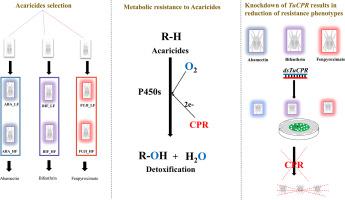当前位置:
X-MOL 学术
›
Pestic. Biochem. Phys.
›
论文详情
Our official English website, www.x-mol.net, welcomes your
feedback! (Note: you will need to create a separate account there.)
RNA interference of NADPH-cytochrome P450 reductase increases susceptibilities to multiple acaricides in Tetranychus urticae
Pesticide Biochemistry and Physiology ( IF 4.2 ) Pub Date : 2020-05-01 , DOI: 10.1016/j.pestbp.2020.02.016 Adekunle W Adesanya 1 , Antonio Cardenas 2 , Mark D Lavine 1 , Douglas B Walsh 1 , Laura C Lavine 2 , Fang Zhu 3
Pesticide Biochemistry and Physiology ( IF 4.2 ) Pub Date : 2020-05-01 , DOI: 10.1016/j.pestbp.2020.02.016 Adekunle W Adesanya 1 , Antonio Cardenas 2 , Mark D Lavine 1 , Douglas B Walsh 1 , Laura C Lavine 2 , Fang Zhu 3
Affiliation

|
The two-spotted spider mite, Tetranychus urticae, is a polyphagous pest feeding on over 1100 plant species, including numerous highly valued economic crops. The control of T. urticae largely depends on the use of acaricides, which leads to pervasive development of acaricide resistance. Cytochrome P450-mediated metabolic detoxification is one of the major mechanisms of acaricide resistance in T. urticae. NADPH-cytochrome P450 reductase (CPR) plays as a crucial co-factor protein that donates electron(s) to microsomal cytochrome P450s to complete their catalytic cycle. This study seeks to understand the involvement of CPR/P450 in acaricide resistance in T. urticae. The full-length cDNA sequence of T. urticae's CPR (TuCPR) was cloned and characterized. TuCPR was ubiquitously transcribed in different life stages of T. urticae and the highest transcription was observed in the nymph and adult stages. TuCPR was constitutively over-expressed in six acaricide resistant populations compared to a susceptible one. TuCPR transcriptional expression was also induced by multiple acaricides in a time-dependent manner. Down-regulation of TuCPR via RNA interference (RNAi) in T. urticae led to reduced enzymatic activities of TuCPR and cytochrome P450s, as well as a reduction of resistance to multiple acaricides, abamectin, bifenthrin, and fenpyroximate. The outcome of this study highlights CPR as a potential novel target for eco-friendly control of T. urticae and other related plant-feeding pests.
中文翻译:

NADPH-细胞色素 P450 还原酶的 RNA 干扰增加了荨麻疹中多种杀螨剂的敏感性
二斑叶螨 Tetranychus urticae 是一种杂食性害虫,以 1100 多种植物为食,包括许多高价值的经济作物。T. urticae 的控制很大程度上取决于杀螨剂的使用,这导致杀螨剂抗性的普遍发展。细胞色素 P450 介导的代谢解毒是荨麻疹抗杀螨剂的主要机制之一。NADPH-细胞色素 P450 还原酶 (CPR) 作为一种关键的辅助因子蛋白,向微粒体细胞色素 P450 提供电子以完成其催化循环。本研究旨在了解 CPR/P450 与 T. urticae 杀螨剂抗性的关系。T. urticae 的 CPR (TuCPR) 的全长 cDNA 序列被克隆和表征。TuCPR 在 T 的不同生命阶段普遍转录。在若虫和成虫阶段观察到最高的转录。与易感群体相比,TuCPR 在六个抗杀螨剂群体中组成性地过度表达。多种杀螨剂也以时间依赖性方式诱导 TuCPR 转录表达。通过荨麻疹中的 RNA 干扰 (RNAi) 下调 TuCPR 导致 TuCPR 和细胞色素 P450 的酶活性降低,以及对多种杀螨剂、阿维菌素、联苯菊酯和苯吡菌胺的抗性降低。这项研究的结果突出了 CPR 作为生态友好型控制荨麻疹和其他相关植食性害虫的潜在新目标。多种杀螨剂也以时间依赖性方式诱导 TuCPR 转录表达。通过荨麻疹中的 RNA 干扰 (RNAi) 下调 TuCPR 导致 TuCPR 和细胞色素 P450 的酶活性降低,以及对多种杀螨剂、阿维菌素、联苯菊酯和苯吡菌胺的抗性降低。这项研究的结果突出了 CPR 作为生态友好型控制荨麻疹和其他相关植食性害虫的潜在新目标。多种杀螨剂也以时间依赖性方式诱导 TuCPR 转录表达。通过荨麻疹中的 RNA 干扰 (RNAi) 下调 TuCPR 导致 TuCPR 和细胞色素 P450 的酶活性降低,以及对多种杀螨剂、阿维菌素、联苯菊酯和苯吡菌胺的抗性降低。这项研究的结果突出了 CPR 作为生态友好型控制荨麻疹和其他相关植食性害虫的潜在新目标。
更新日期:2020-05-01
中文翻译:

NADPH-细胞色素 P450 还原酶的 RNA 干扰增加了荨麻疹中多种杀螨剂的敏感性
二斑叶螨 Tetranychus urticae 是一种杂食性害虫,以 1100 多种植物为食,包括许多高价值的经济作物。T. urticae 的控制很大程度上取决于杀螨剂的使用,这导致杀螨剂抗性的普遍发展。细胞色素 P450 介导的代谢解毒是荨麻疹抗杀螨剂的主要机制之一。NADPH-细胞色素 P450 还原酶 (CPR) 作为一种关键的辅助因子蛋白,向微粒体细胞色素 P450 提供电子以完成其催化循环。本研究旨在了解 CPR/P450 与 T. urticae 杀螨剂抗性的关系。T. urticae 的 CPR (TuCPR) 的全长 cDNA 序列被克隆和表征。TuCPR 在 T 的不同生命阶段普遍转录。在若虫和成虫阶段观察到最高的转录。与易感群体相比,TuCPR 在六个抗杀螨剂群体中组成性地过度表达。多种杀螨剂也以时间依赖性方式诱导 TuCPR 转录表达。通过荨麻疹中的 RNA 干扰 (RNAi) 下调 TuCPR 导致 TuCPR 和细胞色素 P450 的酶活性降低,以及对多种杀螨剂、阿维菌素、联苯菊酯和苯吡菌胺的抗性降低。这项研究的结果突出了 CPR 作为生态友好型控制荨麻疹和其他相关植食性害虫的潜在新目标。多种杀螨剂也以时间依赖性方式诱导 TuCPR 转录表达。通过荨麻疹中的 RNA 干扰 (RNAi) 下调 TuCPR 导致 TuCPR 和细胞色素 P450 的酶活性降低,以及对多种杀螨剂、阿维菌素、联苯菊酯和苯吡菌胺的抗性降低。这项研究的结果突出了 CPR 作为生态友好型控制荨麻疹和其他相关植食性害虫的潜在新目标。多种杀螨剂也以时间依赖性方式诱导 TuCPR 转录表达。通过荨麻疹中的 RNA 干扰 (RNAi) 下调 TuCPR 导致 TuCPR 和细胞色素 P450 的酶活性降低,以及对多种杀螨剂、阿维菌素、联苯菊酯和苯吡菌胺的抗性降低。这项研究的结果突出了 CPR 作为生态友好型控制荨麻疹和其他相关植食性害虫的潜在新目标。











































 京公网安备 11010802027423号
京公网安备 11010802027423号